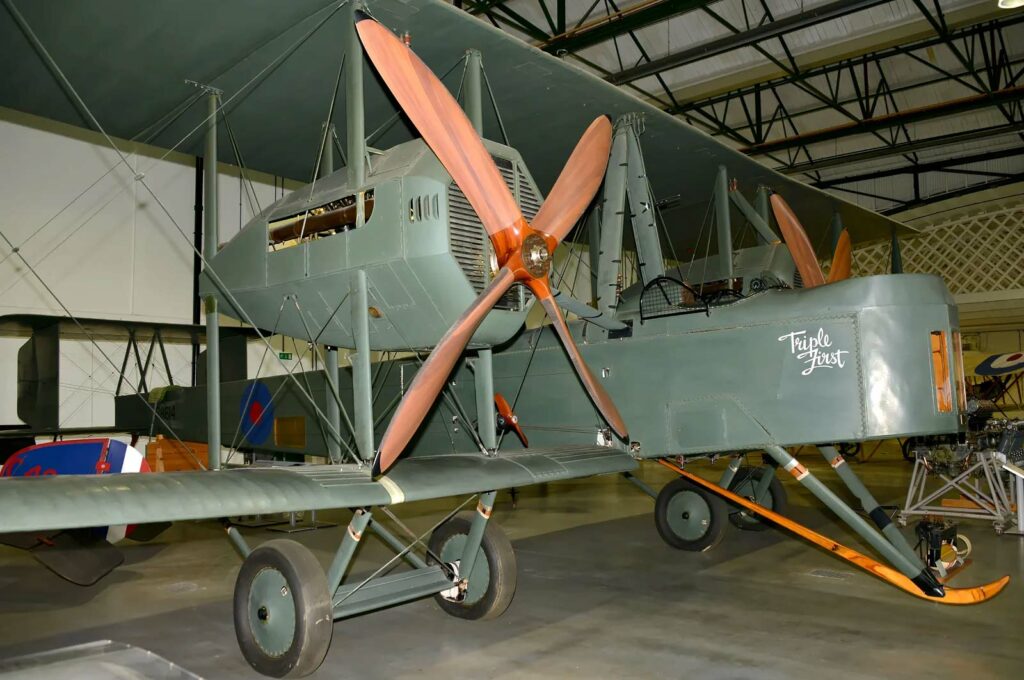Vickers Vimy: WWI-era British heavy bomber, distinguished by twin-engine biplane design, notable for pioneering long-distance flights. The Vickers Vimy was a significant British aircraft designed during World War I, embodying the technological advances of the era. This heavy bomber was instrumental in showcasing the potential of aviation in long-range flights and aerial combat, despite entering service too late to influence wartime operations significantly.
As aviation technology surged during World War I, the demand for more capable and reliable aircraft led to the development of the Vickers Vimy. This aircraft became a symbol of the rapid advancement in aviation capability and the potential for aircraft to conduct long-range operations.
History of the Development of the Vickers Vimy
The historical backdrop of World War I saw the rising strategic importance of aerial capability. The British war effort required a robust, long-range bomber to penetrate deep into enemy territory, which led to the inception of the Vickers Vimy. Vickers Limited undertook the design and development of the aircraft, spearheaded by chief designer Reginald Kirshaw “Rex” Pierson. The aim was to create a bomber that could carry substantial payloads over long distances with reliability and relative safety.
The development program was launched amidst the grim reality of war, where attrition rates for pilots and aircraft were high, and the pressure to deliver an operational advantage was intense. The Vickers Vimy first took to the skies on November 30, 1917. By the time it was ready for service, the Armistice was signed, and it did not have the opportunity to demonstrate its capabilities in wartime operations.
Design of the Vickers Vimy
The Vickers Vimy was a large aircraft for its time, with a wingspan of 68 feet (20.73 meters) and a length of 43 feet 6.5 inches (13.27 meters). It featured a biplane design, which was typical of the era, but combined it with a robust twin-engine configuration that provided sufficient power to lift heavier payloads than most contemporary aircraft. The Vimy’s structure was predominantly constructed from wood and fabric, a common practice that provided a good balance between strength and weight.
One of the design’s main advantages was its large fuselage capable of accommodating significant bomb loads and fuel for extended range missions. The twin-engine design also provided redundancy, increasing the aircraft’s chances of returning from a mission even if one engine failed—a considerable advantage over single-engine bombers of the time.
However, the Vimy’s size and weight posed challenges, particularly in terms of handling and maneuverability. The biplane design, with its multiple wing surfaces and struts, created drag that limited its top speed.

Performance of the Vickers Vimy
Powered by two Rolls-Royce Eagle VIII engines, each producing 360 horsepower, the Vimy could reach a maximum speed of 100 mph (160 km/h) and had a service ceiling of 7,000 feet (2,134 meters). With a range of up to 900 miles (1,448 kilometers), it was capable of undertaking long-distance missions, a significant advantage over the enemy’s aircraft with lesser endurance.
Compared to its contemporaries, such as the German Gotha bombers, the Vimy’s payload and range were superior, though it sacrificed speed and agility. Its capability was exemplified by the record-breaking flights it made post-war, which included the first non-stop transatlantic flight and the first flight from England to Australia.
Military Use and Combat of the Vickers Vimy
Though the Vimy was designed as a heavy bomber capable of carrying up to 2,476 pounds (1,123 kg) of bombs, it saw limited military use during its service life. It entered service too late to participate actively in World War I but served with distinction in various roles in the years following the war.
There were no direct competitors in operation as the Vimy was transitioning from a military to a civil role. It was never sold to other countries for military purposes but laid the groundwork for subsequent bomber designs. The Vimy was eventually replaced by more advanced aircraft as aviation technology progressed rapidly in the post-war years.
The Vickers Vimy epitomized the innovative spirit of aviation during and after World War I. Though it did not have the opportunity to prove itself in combat, its design and subsequent historic flights demonstrated the potential of aircraft to undertake roles that had previously been unimaginable. It paved the way for future long-range bombers and left an indelible mark on the annals of aviation history.
Back to the Bombers section.